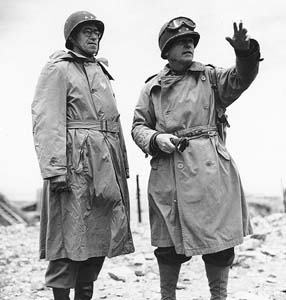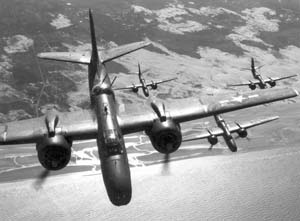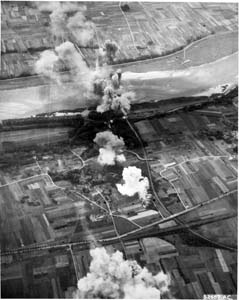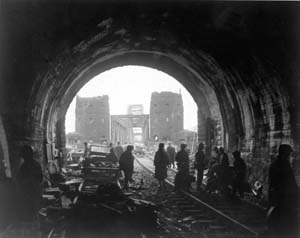At the end of World War II, the US Army brass in Europe sang the praises of airpower. For the first time, airpower influenced the design for major campaigns—and made a difference in the tactical outcomes of battles from Normandy to Remagen, Germany.
Lost in dense volumes of after-action analyses was one of the most unusual and compelling reports ever written on airpower. The report, titled “Effect of Air Power on Military Operations: Western Europe,” was authored by Army ground officers. The Air Effects Committee of 12th Army Group consisted of Army infantry officers drawn from the air branches of G-3 (operations) and G-2 (intelligence) of 12th Army Group. The man who signed off on the report on July 15, 1945, in Wiesbaden, Germany, was none other than Army Gen. Omar N. Bradley, four-star commander of 12th Army Group.
Today it’s uncommon for senior ground commanders to spend time and resources analyzing airpower’s role at the operational level of war. This was not the case in 1945. Writing up airpower’s scorecard was deemed a vital task—so much so, it had to be completed before forces rotated back to the United States.
As American airpower starts its third decade in action in US Central Command, it is instructive to look back at how air superiority, interdiction, reconnaissance, and lift affected the war in Europe—and why the Army valued those lessons.
 |
Maj. Gen. J. Lawton Collins, commander of VII Corps, describes to Lt. Gen. Omar Bradley (l) how Cherbourg, France, was taken in 1944. |
Bradley’s 12th Army Group was the largest American force ever assembled on a field of battle. His four field army commanders—including Lt. Gen. George S. Patton Jr. at the head of Third Army— had 48 divisions and 1.3 million men among them.
Days after the war ended, Gen. Dwight D. Eisenhower, the supreme allied commander in Europe, wanted to know: How well had airpower done in supporting this victorious force? The answers came back in a 195-page report, with two appendices, drawn from the fresh combat experiences of the ground forces. An opening section discussed strategic bombing, but the bulk of the report covered the role of airpower in the 11 months from June 6, 1944, to the surrender of the German high command on May 8, 1945. Behind it all was the idea of assessing how well air and ground worked together. Tactical engagements were important and many dramatic ones were cited throughout the report. But the overall idea was to evaluate airpower at the operational level of war, where major campaigns carried out Allied strategy.
Twelfth Army Group wanted three operational effects from airpower: air superiority being the first, with the second being the use of airpower to isolate the battlefield by preventing effective movement of enemy troops. The third, richly discussed in tactical detail, was the “combined effort of the air and ground forces, in the battle, to gain objectives on the immediate front of the ground forces.”
An Underlying Theme The first two were a roaring success. On the third point, commanders found airpower highly effective in rapid maneuver, but prone to bogging down just like the ground forces when facing dug-in resistance.
Control of the skies was a new luxury. Beginning with Normandy, the Allies enjoyed real air superiority for the first time.
“In contrast with air operations in North Africa, air superiority and sufficient forces allowed the air-ground team to use the air umbrella effectively,” noted historian David N. Spires, in his book Air Power for Patton’s Army. The 12th AG was profoundly grateful that air superiority had prevented the German Luftwaffe from attacking England during the buildup for cross-Channel operations. The report spent some time reminiscing and citing statistics on how vulnerable the congested English ports and ammunition dumps would have been to air attack in early 1944.
Once Allied troops were ashore in Normandy, air superiority underwrote the whole maneuver plan, as intended. “During the rest of the campaign, our air superiority was so conclusive that it was an accepted factor in all planning and, of course, forms the underlying theme of this report,” summed up the authors.
 |
A Ninth Air Force A-20 over France. |
There were exceptions, such as when a flight of eight P-47s chased off 18 Luftwaffe aircraft attempting a dive bombing run five miles east of Dreux, France. Many infantry soldiers in the three main armies told stories about daylight strafing attacks. But the Luftwaffe was drained beyond the point where it could seriously affect ground operations. Finally, the Allies had control of the skies and sufficient aircraft, though replacing combat losses continued to pose difficulties. With air superiority virtually achieved, the land forces could task airpower to seal off sections of the battlefield and set conditions for successful close combat.
Twelfth Army Group and other Allied troops faced nearly 60 German divisions. Also, the Germans were ensconced in the world’s most sophisticated rail and road transportation system. Isolating the battlefield so German commanders could not easily move reinforcements was a top assignment for airpower.
Isolation operations began before the D-Day invasion with the elimination of rail bridges over the Seine, for example. From experience in Italy, the Allies learned strikes against rail marshalling yards interrupted traffic for only short periods.
Attacking bridges was the real key to blocking off areas of the battlefield. Myths about thousands of bombers tasked to knock out a single target have misrepresented the actual tactics of Ninth Air Force’s bridge-bombing experts. Extreme low-level attacks by fighter-bombers such as the A-20 dropped bridges with great efficiency, often in a single raid. Airmen could cut any bridge selected by 12th Army Group—although they took losses and sometimes needed repeat attacks on bridges through heavy flak. “Attacks on bridges … imposed a maximum of delay on the movements of German forces and supplies, [and] increased the fuel shortage in the battle area by forcing long road detours,” said the report. “In addition, destruction of the bridges created temporary blocks behind which rail and road traffic piled up, thus affording admirable targets for fighter-bombers.”
At the outer arc, German troops disembarked their trains far away from the leading edge of the battle. Half the troops who detrained at the Loire River in France had to march for six to 12 days to move into battle positions. Retreat in good order was difficult for the same reason. The beachhead and breakout areas were never impermeable, but air attack slowed reinforcement to a sluggish pace. The result? “The enemy was unable to use the rail system inside the Seine-Loire area for any large-scale movement of troops.”
Twelfth Army called on airpower to isolate the battlefield many times. In early 1945, air isolation proved vital again during the race for the Rhine bridges into Germany. Although German forces were retreating, shorter distances made it easier to reinforce and counterattack in some cases.
Hitler himself ordered in all reserves when the Allies broke through at Remagen. The Ludendorff Bridge over the Rhine was captured intact on March 7, 1945, when explosives rigged by the Germans failed to detonate. The Allies used the bridge for 10 days before it collapsed, crossing five divisions of men and equipment.
To block the counterattack, 9th Tactical Air Command hit marshalling yards feeding rail traffic to the bridgehead area. Weather often forced blind bombing techniques, but it worked anyway. Hitler’s reinforcements were forced from rail to road, which prevented the Germans from containing the bridgehead. Finally there was the daily art of using airpower for immediate front-line forces. Close air support was effective, but what the Army truly embraced was partnering with airpower for rapid maneuver.
The Devil in the Details This was no wartime expedient. The long drive toward mobility, which began in the last phases of World War I, saw Army thinking trade heavy firepower and trench lines for lighter, mobile “open” warfare. Tanks were a centerpiece, and air would be vital in providing firepower. Airpower had to be part of the equation for achieving rapid breakout and advance. The young officers on the eve of World War II were quite air-minded. Eisenhower and Patton both learned to fly before the war, and the wealthy Patton even bought his own airplane. In the late 1930s, new Army divisions emphasized speed and mobility “which meant that medium rather than heavy artillery became the standard issue,” wrote historian Spires. Twelfth Army now took advantage of the conditions of air superiority established in the intense air war of the past two years.
The Allies counted on airpower to speed them ahead in the breakout across France in the summer of 1944. Tactical airpower met some of its toughest tasks in support of fast-moving armies—Patton’s Third Army, Lt. Gen. Courtney H. Hodges’ First Army, and Lt. Gen. William H. Simpson’s Ninth Army.
 |
Heavy bombers from Eighth Air Force destroy a bridge in France, hindering German troop reinforcements.
|
From 12th Army Group’s perspective, the overall success of close air support depended on whether armies were moving fast or bogged down. On balance, 12th Army Group liked its close air support best when armored columns were sprinting ahead under constant air cover. Flights were allocated on a steady basis—what was in later decades termed “push CAS.” In the summer of 1944, they called it armored column cover. Incoming flights checked in by radio with forward airmen ground controllers in tanks and with the flight lead of aircraft already over columns. They “disposed” of any immediate targets, as the report put it, and then ranged up to 30 miles ahead of the column “in an intensive search for enemy vehicles, troops, or artillery.” Armored column cover marked the apex of airpower in maneuver warfare. The biggest dilemmas faced at 12th Army Group came from apportioning air support when requests multiplied and the tactical situation sagged.
In those cases, air commanders had to divide efforts between interdiction for moving forces and extra airpower to tip the balance against German strongholds.
Complaints about air support burgeoned when the armies slowed down and faced hardened opposition from the Germans. The principal reason was demand for air support outstripped supply both in tactical engagements and in commanders’ choices about which operations to support.
“During periods when movement was relatively slow, requests were numerous and frequent from corps and divisions for close support fighter-bomber attacks against enemy strong points, dug-in infantry, dug-in tanks, and self-propelled guns as well as other artillery,” noted the report.
Not all taskings could be filled. The effects were not as great as they were against German forces in the open. Airpower in these engagements was described in terms such as “softening up and blasting out enemy strong points.” It had little effect on concrete pillboxes and guns in casements. Likewise, dug-in infantry were harder to shake than troops in the open.
As usual, the devil was in the details. At first, airmen and soldiers preferred not to approve close support requests for targets within range of field artillery. But as they found at Normandy, sometimes organic artillery did not show up on time or as planned. It “became apparent to staff officers in the combined air-ground operations centers that various factors affected this preconceived tenet, and that each request should be considered from all angles” rather than being denied outright, the report concluded.
As it turned out, this tactical close support was wildly popular. Fighter-bombers could drop heavier ordnance at closer range than artillery, in many cases. “Effective bombing with 500-pound [general-purpose] or 260-pound fragmentation bombs was conducted by fighter-bombers against close-in enemy positions, sometimes within 300 to 500 yards of our own forward elements,” wrote the appreciative soldiers. Many commanders felt that concentrated fighter-bomber attack on close-in enemy positions was worth more than any artillery preparation, if the air attack was followed immediately by a determined infantry attack.
The operational-level division of effort was also a problem—and one that 12th Army Group knew well. Should air be focused on armored column cover or break off to help break resistance where the armies bogged down?
A case in point was the two-week diversion of sorties to Brest, France, where the Allies were trying to eliminate a German stronghold in order to free up use of the Brittany ports. Brest was Ninth Air Force’s top priority on Sept. 3, 1944. Units attacked German troop positions, pillboxes, and coastal batteries. Maj. Gen. Otto P. Weyland went so far as to assign four-airplane patrols to each division to form a miniature umbrella over the town. Napalm was employed on a major scale, and in the final phases, P-47s identified and attacked individual fortified houses, in what amounted to house-to-house fighting, Spires recounted.
Brest eventually fell on Sept. 18, amidst ringing praise for the close air support delivered. However, both air and ground commanders decried the diversion from Patton’s main offensive which was seeking airpower to isolate the battle area prior to crossing the Mosel River. Commanders still hoped for decisive ground action to cause a collapse in the west before autumn ran out. Patton had logistical problems, but the wrangling over allocation of air effort didn’t help.
All this air support came at a cost. Preinvasion planning anticipated average loss rates of 20 percent of each unit’s aircraft per month. According to historian Will A. Jacobs, Ninth Air Force lost 295 fighters in June 1944 alone, a 25 percent loss of its equipment strength. December 1944 saw an even higher loss rate of 28.6 percent.
Loss rates per sortie were low, but high operations tempo drove up attrition. “The relatively lower risk of a sortie over occupied France was offset by the high number of such sorties … in a given period,” Jacobs concluded.
Bombs and strafing weren’t the only methods of support. One of the report’s most intriguing findings was supplies delivered by airlift often made a crucial tactical difference.
 |
US troops and equipment move across the Ludendorff Bridge in Germany. With airpower isolating the German troops near Remagen, the Allies were able to use the bridge to cross the Rhine. |
Patton’s Third Army could gobble up air-delivered supplies. Total supplies delivered by air were a small percentage of total volume. However, the airlift during certain crucial phases of the campaign assisted the continued advance of spearheads and gave the final impetus to operations east of the Rhine, said the report.
Details Speak for Themselves Critical air supply made a difference in Normandy with resupply for paratroopers of the 82nd and 101st Airborne Divisions, which got 500 tons of canister or glider drops during the first week after D-Day, before emergency landing fields were ready. For the rest of June, airlift made up critical shortfalls in blood, plasma, and 105 mm howitzer ammunition. Approximately 6,649 casualties were flown out during the first three weeks—almost a quarter of total evacuees.
Another chance for airlift to bail out maneuver operations came in late August 1944. Third Army needed 7,000 tons of air-delivered supplies—and sent back 11,600 casualties. The best method was delivery to hastily prepared airfields. The single most famous incident, of course, was the airdrop and glider delivery of 850 tons of supplies to the surrounded 101st Division holding the vital communications center at Bastogne during the Battle of the Bulge.
Finally, the last race into Germany again saw Patton’s Third Army outrunning its supply lines. “Between 30 March and 9 May, 22 percent of all the gasoline delivered to the Third Army arrived by airlift,” the report found.
Twelfth Army Group’s authors were not shy about analyzing the shortcomings of airpower or dissecting cases where bad decisions restricted effectiveness. They often had a bone to pick with airlift being set aside for airborne operations that were later canceled.
There were problems airpower never surmounted in Europe, such as night operations.
From the Normandy invasion through the Ardennes and Remagen, “it was apparent that a lack of night air activity allowed the enemy the freedom of movement which he had lost by day.” Enemy air activity ginned up around dusk.
Although there were eventually two night fighter squadrons operating in 12th AG’s area, it wasn’t nearly enough to let them capitalize on the German habit of forming up columns for movement at night. Navy carriers in the Pacific had fielded night fighter units earlier in the war, but the procedures never matured for the European Theater.
Then there was weather. “Weather in this theater was a critical limitation on the use of airpower,” the report stated flatly. Radar bombing aids were useful on occasion. Bombing missions on rail yards around the Remagen bridgehead were lauded as outstanding examples of the effectiveness of blind bombing. Still, the Ardennes salient and many other incidents confirmed weather was a constant trial that kept airpower out of action at critical moments.
For all its tactical candor, there was much the report of 12th Army Group could not say. One missing piece was the exploitation of intelligence through Ultra, the intelligence decryption program.
Another was subtler: Airpower worked in part because of the close working relationships between field army and tactical air force commanders. Bradley himself started out exasperated about the fact that air forces were not available for more air-to-ground training before the Normandy invasion. He was soon reveling in the close relationship with air support for First Army, provided by Maj. Gen. Elwood R. Quesada, commander of 9th Tactical Air Command. “This man Quesada is a jewel,” Bradley said later.
Bradley left discussion of air tactics strictly to airmen. He delivered to Eisenhower “a careful review of … how our operations were affected by our tremendous advantage in airpower.” No wild declarations about airpower were needed; the detailed results spoke for themselves. Through their careful analysis and attention to both tactical and operational implications, 12th Army Group’s soldiers gave airpower a resounding cheer.
Rebecca Grant is president of IRIS Independent Research. She has written extensively on airpower and serves as director, Mitchell Institute, for AFA. Her most recent article for Air Force Magazine, “Desert Shield,” appeared in the August issue.